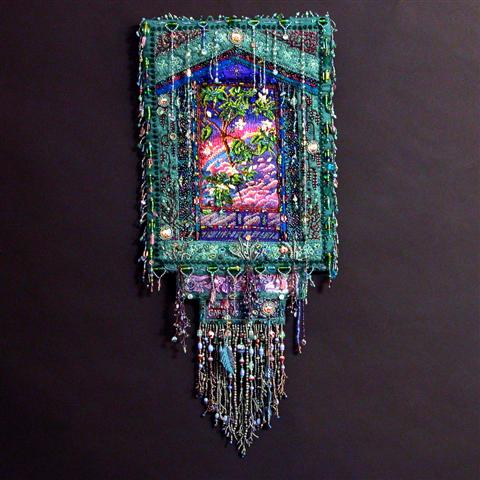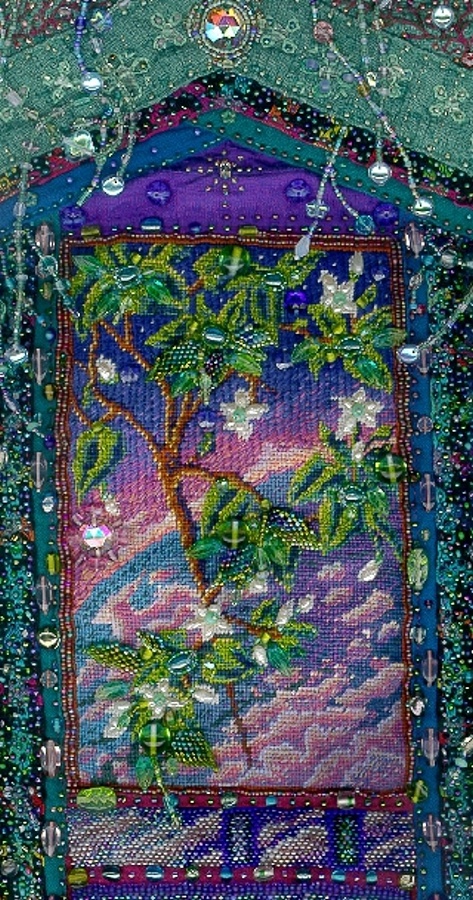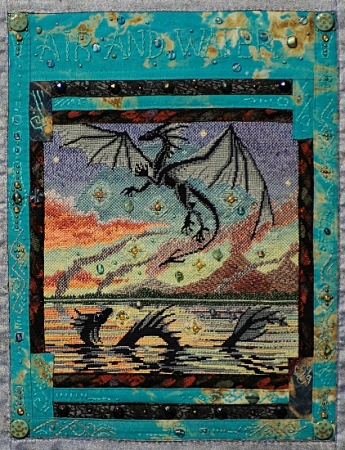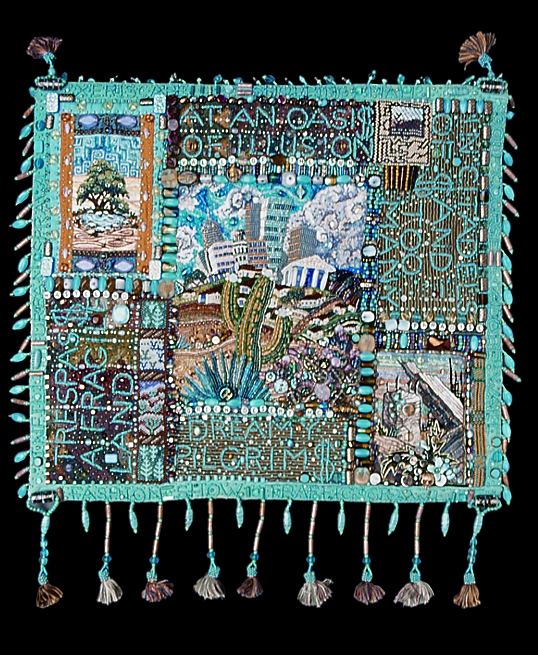From 1995 (when I started the needlepoint central panel) comes the wall tapestry ‘Hanging Garden’.

This was a fun piece to do, beginning with a dream and a sketch in 1994, of a fantasy garden and a tree stretching from the ground to above the clouds. (Yes, I already had the dizzyingly tall gir-trees of Lonhra in my personal mythos.)
I hand-painted the cotton canvas, then embroidered in glass beads and freshwater pearls before starting on the cotton and silk-floss needlepoint.
Here’s a detail scan of the central panel.

I was riding public transit to work at the time, so this piece became my commuter project for over a month.
Once the needlepoint was done, and the 3D beaded leaves added, I appliqued the panel into a wall-hanging fringed with beads.
The tapestry got some notice at local embroidery shows, was shown in a beadwork magazine, and eventually sold to a folk art museum back East.
I’m thinking about new ways to approach the idea. Another wall hanging? A fiber art book, with tall vertical panels? Ornate side panels on an ethnic-style coat or long vest?
***
These old pieces are a little like razors dipped in stardust and honeysuckle nectar: I’m proud of them, they have some remembered magic, but they also mark a stressful time in my life.
From 1990-1994 I was effectively unemployed most of the time and artistically at sea. I wasn’t sure what I wanted to do and make. I had supportive friends and family. I was just beginning to ramp up my creative skills.
I didn’t have a backbone, few research & business skills, or any idea how to convince people to pay me what my art was worth. Or that my art was worth anything. Or how to make it worth anything.
(That answer, though hard to learn, is simple: Do my best. Tell buyers, “This is the minimum for which I can sell this piece. You don’t agree? Don’t buy it. Have a nice day.”)
Back in the early to mid-90s I was still feeling my way. I believed the stupid myth of working for ‘exposure’.
I tried selling my art at local science fiction conventions, and giving away small pieces as charity auction items.
I tried selling needlepoint bookmarks, beaded bracelets, and wall hangings at a beloved local New Age book and supply store. (I won’t say the owner was a crook, because I was the idiot who deeply undervalued my work. She just happily went along with it.) That store closed only a couple of years ago. I wonder how many other artists cheated themselves, there?
In 1990 I got suckered for $250 and some expensive transparencies to an ‘art marketing’ scam purporting to show artwork to local designers and corporations. Which went bankrupt immediately because it already had serious competition I didn’t know about. The two owners later wound up getting sued for similar scams involving auto sales.
Most of these smaller fiber art pieces sold for under $100 each. I don’t even have good pictures of most of them.
***
Fiber work didn’t come to me out of nothing.
My mother had been a world-class sewist and needlepoint crafter, who taught me to thread a needle around the time I was five.
I’d embroidered and done beadwork since the mid-80s. A Farmington, New Mexico gallery called Gallery 20 and a stint in the Society for Creative Anachronism, Inc. pulled me into fiber art from an obsession with silversmithing.
Moving to Phoenix in the late 80s, I did manufacturing and trade jobs: tangent to art, but certainly not fine art or craft.
The first ‘tapestry’ I made in 1990 was almost an accident: a small semi-abstract landscape I called ‘Storm Warning’. It became my first entry in the art marketing scam.
My second, also in 1990, was ‘Incandescent Willows’, a red and brown botanical themed piece. It was lost when the scammers cut and ran. (I didn’t love it enough to fight for its return from their creditors.)
‘Creatrix’, 1991, was a goddess embroidered over a white satin ice-ball Earth, only a thin ribbon of green and life around its equator.
‘Lake Spirits’, 1992, was a dark-robed sorceress standing in waves and holding a goblet to her lips.
‘Kashmir-Cuzco Express’, 1993, was a green-winged dragon framed by tatters of ethnic embroidery.
‘Zen Moon’, 1994, was the first iteration of a design I’d use again: a Yin-yang symbol incorporating a tree and a hill. This one was worked in dark purple, black, and pink, against a pale pink full moon.
‘Seven Stars’, 1994, used iridescent glass buttons and black velvet in a riff on Tolkien imagery.
‘Moonflight’, 1994, showed a black dragon against a blue-purple background. It was stylistically similar but not as good as 1995’s ‘Air and Water’ (below) which I still own.

What changed?
I got steadier work, first in retail then in art manufacturing…for the long-established competition of the art-marketing scammers!
For everyone who bleats myths about how suffering and poverty make for better artists: pound sand and then eat it.
A *tiny* financial cushion helped me immeasurably. I had room to grow. I grieve for all the artists and potential artists who never get that. I think a Universal Basic Income could boost lives and economies.
By my standards now, I remember these small tapestries as ‘okay’ pieces, not showstoppers like 2002’s ‘Green Desert’…which went on a national show tour and sold for $5000 to a Colorado collector.

That sale made me rethink everything I’d tried or believed before. By early 2002, I had been steadily employed for six years, was deep into my book art obsession, and eight months from signing with a ‘real’ fine-crafts gallery in Scottsdale AZ.
It took a long time, good luck, courage, and support to grow into a spine, a sense of self-worth, and the skills needed to make the art I wanted to create.
I toy sometimes with rebuilding some of those early pieces, but mostly I am happy to forge ahead.